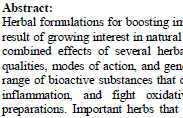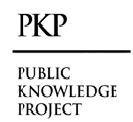Combination Effects of Herbal Formulations for Enhanced Immune Support: A Comprehensive Review
Keywords:
Herbal Formulations, Immune Support, Antioxidant Activity, Quality ControlAbstract
Herbal formulations for boosting immune support are becoming more popular as a result of growing interest in natural therapies. This thorough analysis examines the combined effects of several herbal preparations, emphasizing their synergistic qualities, modes of action, and general benefits on immunological health. A wide range of bioactive substances that cooperate to regulate immune responses, lower inflammation, and fight oxidative stress are frequently found in herbal preparations. Important herbs that have important functions in boosting immune function through antioxidant activity, cytokine regulation, and antiviral actions include clove (Syzygium aromaticum), ginger (Zingiber officinale), garlic (Allium sativum)the significance of comprehending how various herbs interact with one another since these mixtures can increase therapeutic efficacy beyond that of their individual parts
Downloads
References
Motti R. Wild plants used as herbs and spices in Italy: An ethnobotanical review. Plants. 2021 Mar 16;10(3):563.
Chrysant SG, Chrysant GS. Herbs used for the treatment of hypertension and their mechanism of action. Current hypertension reports. 2017 Sep;19:1-0.
Liu H, Lu X, Hu Y, Fan X. Chemical constituents of Panax ginseng and Panax notoginseng explain why they differ in therapeutic efficacy. Pharmacological research. 2020 Nov 1;161:105263.
Liu X, Zhang M, He L, Li Y. Chinese herbs combined with Western medicine for severe acute respiratory syndrome (SARS). Cochrane Database of Systematic Reviews. 2012(10).
Cho EC, Kim K. A comprehensive review of biochemical factors in herbs and their constituent compounds in experimental studies on alopecia. Journal of ethnopharmacology. 2020 Aug 10;258:112907.
Kaefer CM, Milner JA. The role of herbs and spices in cancer prevention. The Journal of nutritional biochemistry. 2008 Jun 1;19(6):347-61.
Wei J, Juan N, Wu T, Chen X, Duan X, Liu G, Qiao J, Wang Q, Zhen J, Zhou L, Ni J. Chinese medicinal herbs for acute bronchitis. Cochrane Database of Systematic Reviews. 2005(3).
Osman AG, Haider S, Chittiboyina AG, Khan IA. Utility of alkaloids as chemical and biomarkers for quality, efficacy, and safety assessment of botanical ingredients. Phytomedicine. 2019 Feb 15;54:347-56.
Raeisossadati MJ, Danesh NM, Borna F, Gholamzad M, Ramezani M, Abnous K, Taghdisi SM. Lateral flow based immunobiosensors for detection of food contaminants. Biosensors and Bioelectronics. 2016 Dec 15;86:235-46.
Deutch MR, Grimm D, Wehland M, Infanger M, Krüger M. Bioactive candy: effects of licorice on the cardiovascular system. Foods. 2019 Oct 14;8(10):495.
Giacometti J, Kovačević DB, Putnik P, Gabrić D, Bilušić T, Krešić G, Stulić V, Barba FJ, Chemat F, Barbosa-Cánovas G, Jambrak AR. Extraction of bioactive compounds and essential oils from mediterranean herbs by conventional and green innovative techniques: A review. Food research international. 2018 Nov 1;113:245-62.
Cai Z, Wang C, Zou L, Liu X, Chen J, Tan M, Mei Y, Wei L. Comparison of multiple bioactive constituents in the flower and the caulis of Lonicera japonica based on UFLC-QTRAP-MS/MS combined with multivariate statistical analysis. Molecules. 2019 May 20;24(10):1936.
Liu H, Lu X, Hu Y, Fan X. Chemical constituents of Panax ginseng and Panax notoginseng explain why they differ in therapeutic efficacy. Pharmacological research. 2020 Nov 1;161:105263.
Ma PY, Li XY, Wang YL, Lang DQ, Liu L, Yi YK, Liu Q, Shen CY. Natural bioactive constituents from herbs and nutraceuticals promote browning of white adipose tissue. Pharmacological Research. 2022 Apr 1;178:106175.
Yago, M., and Pla, C. (2020). Reference-mean-centered statistical quality control. Clin. Chem. Lab. Med. 58, 1517–1523. doi:10.1515/cclm-2019-1034
Braga, F., Pasqualetti, S., Aloisio, E., and Panteghini, M. (2020). The internal quality control in the traceability era. Clin. Chem. Lab. Med. 59, 291–300. doi:10.1515/cclm2020-0371
Sharma MC, Sharma S. Phytochemical, preliminary pharmacognostical and antimicrobial evaluation of combined crude aqueous extract. Int J Microbiol Res. 2010;1(3):166-70.
Soni P, Siddiqui AA, Dwivedi J, Soni V. Pharmacological properties of Datura stramonium L. as a potential medicinal tree: an overview. Asian Pacific journal of tropical biomedicine. 2012 Dec 1;2(12):1002-8.
Singh MK, Pandey A, Sawarkar H, Gupta A, Gidwani B, Dhongade H, Tripathi DK. Methanolic extract of Plumbago Zeylanica-a remarkable antibacterial agent against many human and agricultural pathogens. Journal of pharmacopuncture. 2017 Mar;20(1):18.
Khare CP. Indian medicinal plants: an illustrated dictionary. Springer Science & Business Media; 2008 Apr 22.
Brahmachari G, Gorai D, Roy R. Argemone mexicana: chemical and pharmacological aspects. Revista Brasileira de Farmacognosia. 2013;23:559-67.
Čemerski S, Shaw A. Immune synapses in T-cell activation. Current opinion in immunology. 2006 Jun 1;18(3):298-304.
Otáhal P, Angelisová P, Hrdinka M, Brdička T, Novák P, Drbal K, Hořejší V. A new type of membrane raft-like microdomains and their possible involvement in TCR signaling. The Journal of Immunology. 2010 Apr 1;184(7):3689-96.
Tsygankov AY, Bröker BM, Fargnoli J, Ledbetter JA, Bolen JB. Activation of tyrosine kinase p60fyn following T cell antigen receptor cross-linking. Journal of Biological Chemistry. 1992 Sep 15;267(26):18259-62..
Veillette A, Bookman MA, Horak EM, Samelson LE, Bolen JB. Signal transduction through the CD4 receptor involves the activation of the internal membrane tyrosine-protein kinase p56 lck. Nature. 1989 Mar 16;338(6212):257-9..
Veillette A, Bolen JB, Bookman MA. Alterations in tyrosine protein phosphorylation induced by antibody-mediated cross-linking of the CD4 receptor of T lymphocytes. Molecular and cellular biology. 1989 Oct 1;9(10):4441-6..
Chan AC, Dalton M, Johnson R, Kong GH, Wang T, Thoma R, Kurosaki T. Activation of ZAP‐70 kinase activity by phosphorylation of tyrosine 493 is required for lymphocyte antigen receptor function. The EMBO journal. 1995 Jun 1;14(11):2499-508.
Iwashima M, Irving BA, Van Oers NS, Chan AC, Weiss A. Sequential interactions of the TCR with two distinct cytoplasmic tyrosine kinases. Science. 1994 Feb 25;263(5150):1136-9.
Van Oers NS, Killeen N, Weiss A. Lck regulates the tyrosine phosphorylation of the T cell receptor subunits and ZAP-70 in murine thymocytes. The Journal of experimental medicine. 1996 Mar 1;183(3):1053-62.
Weber JR, Ørstavik S, Torgersen KM, Danbolt NC, Berg SF, Ryan JC, Taskén K, Imboden JB, Vaage JT. Molecular cloning of the cDNA encoding pp36, a tyrosine-phosphorylated adaptor protein selectively expressed by T cells and natural killer cells. The Journal of experimental medicine. 1998 Apr 6;187(7):1157-61.
Zhang W, Sloan-Lancaster J, Kitchen J, Trible RP, Samelson LE. LAT: the ZAP-70 tyrosine kinase substrate that links T cell receptor to cellular activation. Cell. 1998 Jan 9;92(1):83-92.
Finco TS, Kadlecek T, Zhang W, Samelson LE, Weiss A. LAT is required for TCR-mediated activation of PLCγ1 and the Ras pathway. Immunity. 1998 Nov 1;9(5):617-26
. Zhang W, Irvin BJ, Trible RP, Abraham RT, Samelson LE. Functional analysis of LAT in TCR-mediated signaling pathways using a LAT-deficient Jurkat cell line. International immunology. 1999 Jun 1;11(6):943-50.
Zhang W, Trible RP, Zhu M, Liu SK, McGlade CJ, Samelson LE. Association of Grb2, Gads, and phospholipase C-γ1 with phosphorylated LAT tyrosine residues: effect of LAT tyrosine mutations on T cell antigen receptor-mediated signaling. Journal of Biological Chemistry. 2000 Jul 28;275(30):23355-61.
Kuo CT, Leiden JM. Transcriptional regulation of T lymphocyte development and function. Annual review of immunology. 1999 Apr;17(1):149-87.
Zhang L, Nabel GJ. Positive and negative regulation of IL-2 gene expression: role of multiple regulatory sites. Cytokine. 1994 May 1;6(3):221-8.
Acuto O, Michel F. CD28-mediated co-stimulation: a quantitative support for TCR signalling. Nature Reviews Immunology. 2003 Dec 1;3(12):939-51.
Dong C. Diversification of T-helper-cell lineages: finding the family root of IL-17-producing cells. Nature Reviews Immunology. 2006 Apr 1;6(4):329-34.
Walker JK, Fong AM, Lawson BL, Savov JD, Patel DD, Schwartz DA, Lefkowitz RJ. β-Arrestin-2 regulates the development of allergic asthma. The Journal of clinical investigation. 2003 Aug 15;112(4):566-74.
Wing K, Sakaguchi S. Regulatory T cells exert checks and balances on self tolerance and autoimmunity. Nature immunology. 2010 Jan;11(1):7-13.
Oppenheim JJ. Cytokines: past, present, and future. Int J Hematol 2001;74:3-8.
O’Sullivan RL, Lipper G, Lerner EA. The neuroimmuno-cutaneous-endocrine network: relationship of mind and skin. Arch Dermatol 1998;134:1431- 1435.
Kiecolt-Glaser JK, McGuire L, Robles TF, Glaser R. Psychoneuroimmunology and psychosomatic medicine: back to the future. Psychosom Med 2002;64:15-28
Kronfol Z, Remick DG. Cytokines and the brain: implications for clinical psychiatry. Am J Psychiatry 2000;157:683-694.
Mittleman BB. Cytokine networks in Sydenham’s chorea and PANDAS. Adv Exp Med Biol
Rader DJ. Inflammatory markers of coronary risk. N Engl J Med 2000;343:1179-1182.
Keystone EC. Tumor necrosis factor-alpha blockade in the treatment of rheumatoid arthritis. Rheum Dis Clin North Am 2001;27:427-443.
Sawant O, Kadam VJ, Ghosh R. In vitro free radical scavenging and antioxidant activity of Adiantum lunulatum. Journal of Herbal medicine and Toxicology. 2009;3(2):39-44.
Saito K, Kohno M, Yoshizaki F, Niwano Y. Extensive screening for edible herbal extracts with potent scavenging activity against superoxide anions. Plant Foods Hum Nutr 2008; 63(2): 65-70.
Cortés-Rojas DF, de Souza CR, Oliveira WP. Clove (Syzygium aromaticum): a precious spice. Asian Pacific journal of tropical biomedicine. 2014 Feb 1;4(2):90-6.
Abd, E.A.M.H.; El-Mesallamy, A.M.D.; El-Gerby, M.; Awad, A. Anti-Tumor, antioxidant and antimicrobial and the phenolic constituents of clove flower buds (Syzygium aromaticum). J. Microb. Biochem. Technol. 2014, 10, s8-s007
Radünz, M.; da Trindade, M.L.; Camargo, T.M.; Radünz, A.L.; Borges, C.D.; Gandra, E.A.; Helbig, E. Antimicrobial and antioxidant activity of unencapsulated and encapsulated clove (Syzygium aromaticum, L.) essential oil. Food Chem. 2019, 276, 180–186. [
Heredia-Guerrero, J.A.; Ceseracciu, L.; Guzman-Puyol, S.; Paul, U.C.; Alfaro-Pulido, A.; Grande, C.; Vezzulli, L.; Bandiera, T.; Bertorelli, R.; Russo, D.; et al. Antimicrobial, antioxidant, and waterproof rtv silicone-ethyl cellulose composites containing clove essential oil. Carbohyd. Polym. 2018, 192, 150–158.
Wankhede, T.B. Evaluation of antioxidant and antimicrobial activity of the Indian clove Syzygium aromaticum L. Merr. and Perr. Int. Res. J. Sci. Eng. 2015, 3, 166–172.
Cui, H.; Zhang, C.; Li, C.; Lin, L. Antimicrobial mechanism of clove oil on Listeria monocytogenes. Food Control 2018, 94, 140–146. [CrossRef] . Li, W.; Chen, H.; He, Z.; Han, C.; Liu, S.; Li, Y. Influence of surfactant and oil composition on the stability and antibacterial activity of eugenol nanoemulsions. LWT-Food Sci. Technol. 2015, 62, 39–47
Li, W.; Chen, H.; He, Z.; Han, C.; Liu, S.; Li, Y. Influence of surfactant and oil composition on the stability and antibacterial activity of eugenol nanoemulsions. LWT-Food Sci. Technol. 2015, 62, 39–47
Li, W.; Chen, H.; He, Z.; Han, C.; Liu, S.; Li, Y. Influence of surfactant and oil composition on the stability and antibacterial activity of eugenol nanoemulsions. LWT-Food Sci. Technol. 2015, 62, 39–47
Nikousaleh, A.; Prakash, J. Antioxidant components and properties of dry heat treated clove in different extraction solvents. J. Food Sci. Technol. 2016, 53, 1993–2000.
Jahanian, E. Clove bud oil; a novel herbal medicine for future kidney researches. Ann. Res. Antioxid. 2016, 1, 27–29.
Jirovetz, L.; Buchbauer, G.; Stoilova, I.; Stoyanova, A.; Krastanov, A.; Schmidt, E. Chemical composition and antioxidant properties of clove leaf essential oil. J. Agric. Food Chem. 2006, 54, 6303–6307
Gülçin, ˙I.; Elmasta¸s, M.; Aboul-Enein, H.Y. Antioxidant activity of clove oil–A powerful antioxidant source. Arab. J. Chem. 2012, 5, 489–499
Adefegha, S.A.; Oboh, G.; Oyeleye, S.I.; Osunmo, K. Alteration of starch hydrolyzing enzyme inhibitory properties, antioxidant activities, and phenolic profile of clove buds (Syzygium aromaticum L.) by cooking duration. Food Sci. Nutr. 2016, 4, 250–260
Akthar, M.S.; Degaga, B.; Azam, T. Antimicrobial activity of essential oils extracted from medicinal plants against the pathogenic microorganisms: A review. Issues Bio. Sci. Pharma. Res. 2014, 2, 001–007.
Marwat, S.K.; Shoaib, M.; Khan, E.A.; Rehman, F.; Ullah, H. Phytochemistry and Bioactivities of Quranic Plant, Zanjabil-Ginger (Zingiber officinale Roscoe): A Review. Am. Eurasian J. Agric. Environ. Sci. 2015, 15, 707–713.
Li, H.; Huang, M.; Tan, D.; Liao, Q.; Zou, Y.; Jiang, Y. Effects of soil moisture content on the growth and physiological status of ginger (Zingiber officinale Roscoe). Acta Physiol. Plant. 2018, 40, 125
Chan, E.W.; Wong, S.K.; Chan, H.T. Alpinia zerumbet, a ginger plant with a multitude of medicinal properties: An update on its research findings. J. Chin. Pharm. 2017, 15, 1. [CrossRef]
Babu, K.N.; Samsudeen, K.; Divakaran, M.; Pillai, G.S.; Sumathi, V.; Praveen, K. Protocols for in vitro propagation, conservation, synthetic seed production, embryo rescue, microrhizome production, molecular profiling, and genetic transformation in ginger (Zingiber officinale Roscoe.). In Protocols for in vitro Cultures and Secondary Metabolite Analysis of Aromatic and Medicinal Plants, 2nd ed.; Humana Press: New York, NY, USA, 2016; pp. 403–426.
Mashhadi, N.S.; Ghiasvand, R.; Askari, G.; Hariri, M.; Darvishi, L.; Mofid, M.R. Anti-oxidative and anti-inflammatory effects of ginger in health and physical activity: Review of current evidence. Int. J. Prev. Med. 2013, 4, 36.
Singh, A.; Rani, R.; Sharma, M. Medicinal Herbs of Punjab (India). Biol. Forum. 2018, 10, 10–27.
Idris, N.A.; Yasin, H.M.; Usman, A. Voltammetric and spectroscopic determination of polyphenols and antioxidants in ginger (Zingiber officinale Roscoe). Heliyon 2019, 5, e01717.
Stoilova, I.; Krastanov, A.; Stoyanova, A.; Denev, P.; Gargova, S. Antioxidant activity of a ginger extract (Zingiber officinale). Food Chem. 2007, 102, 764–770.
Takeuchi, H.; Trang, V.T.; Morimoto, N.; Nishida, Y.; Matsumura, Y.; Sugiura, T. Natural products and food components with anti-Helicobacter pylori activities. World J. Gastroenterol. 2014, 20, 8971.
Shalaby, M.T.; Ghanem, A.A.; Maamon, H.M. Protective effect of ginger and cactus saguaro extract against cancer formation cells. JFDS 2016, 7, 487–491.
Höferl, M.; Stoilova, I.; Wanner, J.; Schmidt, E.; Jirovetz, L.; Trifonova, D.; Stanchev, V.; Krastanov, A. Composition and comprehensive antioxidant activity of ginger (Zingiber officinale) essential oil from Ecuador. Nat. Prod. Commun. 2015, 10, 1085–1090. [CrossRef]
Tohma, H.; Gülçin, ˙I.; Bursal, E.; Gören, A.C.; Alwasel, S.H.; Köksal, E. Antioxidant activity and phenolic compounds of ginger (Zingiber officinale Rosc.) determined by HPLC-MS/MS. J. Food Meas Charact. 2017, 11, 556–566. [CrossRef]
Nile, S.H.; Park, S.W. Chromatographic analysis, antioxidant, anti-inflammatory, and xanthine oxidase inhibitory activities of ginger extracts and its reference compounds. Ind. Crops Prod. 2015, 70, 238–244. [CrossRef]
Tung, B.T.; Thu, D.K.; Thu, N.T.K.; Hai, N.T. Antioxidant and acetylcholinesterase inhibitory activities of ginger root (Zingiber officinale Roscoe) extract. J. Complement. Integr. Med. 2017, 14, 14. [CrossRef]
Chan, E.W.; Lim, Y.Y.; Wong, L.F.; Lianto, F.S.; Wong, S.K.; Lim, K.K.; Joe, C.E.; Lim, T.Y. Antioxidant and tyrosinase inhibition properties of leaves and rhizomes of ginger species. Food Chem. 2008, 109, 477–483. [CrossRef] .
De las Heras, N.; Valero-Muñoz, M.; Martín-Fernández, B.; Ballesteros, S.; López-Farré, A.; Ruiz-Roso, B.; Lahera, V. Molecular factors involved in the hypolipidemic-and insulin-sensitizing effects of a ginger (Zingiber officinale Roscoe) extract in rats fed a high-fat diet. Appl. Physiol. Nutr. Metab. 2016, 42, 209–215. [CrossRef]
Adeniyi, P.O.; Sanusi, R.A.; Obatolu, V.A. Effect of raw and cooked ginger (Zingiber officinale Roscoe) Extracts on insulin sensitivity in normal and high-fat diet-induced diabetic rats. J. Food Nutr. Res. 2017, 5, 838–843.
Abdulrazak, A.; Tanko, Y.; Mohammed, A.; Dikko, A.A. Modulatory roles of clove and fermented ginger supplements on lipid profile and thyroid functions in high fat diet induced insulin resistance in rabbits. Asian J. Med. Sci. 2017, 8, 1–9.
Abdulrazaq, N.B.; Cho, M.M.; Win, N.N.; Zaman, R.; Rahman, M.T. Beneficial effects of ginger (Zingiber officinale) on carbohydrate metabolism in streptozotocin-induced diabetic rats. Br. J. Nutr. 2012, 108, 1194–1201. [CrossRef] [PubMed]
Mozaffari-Khosravi, H.; Talaei, B.; Jalali, B.A.; Najarzadeh, A.; Mozayan, M.R. The effect of ginger powder supplementation on insulin resistance and glycemic indices in patients with type 2 diabetes: A randomized, double-blind, placebo-controlled trial. Complement. Ther. Med. 2014, 22, 9–16. [CrossRef] [PubMed]
Mahluji, S.; Attari, V.E.; Mobasseri, M.; Payahoo, L.; Ostadrahimi, A.; Golzari, S.E. Effects of ginger (Zingiber officinale) on plasma glucose level, HbA1c and insulin sensitivity in type 2 diabetic patients. Int. J. Food Sci. Nutr. 2013, 64, 682–686. [CrossRef] [PubMed]
Akintobi, O.A.; Onoh, C.C.; Ogele, J.O.; Idowu, A.A.; Ojo, O.V.; Okonko, I.O. Antimicrobial activity of Zingiber officinale (ginger) extract against some selected pathogenic bacteria. Nat. Sc. 2013, 11, 7–15.
Naghsh, F. Nano drug delivery study of anticancer properties on ginger using QM/MM methods. Orient J. Chem. 2015, 31, 465–478. [CrossRef]
Shakya, S.R. Medicinal uses of ginger (Zingiber officinale Roscoe) improves growth and enhances immunity in aquaculture. Int. J. Chem. Stud. 2015, 3, 83–87.
Dorra, N.; El-Berrawy, M.; Sallam, S.; Mahmoud, R. Evaluation of Antiviral and Antioxidant Activity of Selected Herbal Extracts. JHIPH 2019, 49, 36–40
Divya, B.J.; Suman, B.; Venkataswamy, M.; Thyagaraju, K. A study on phytochemicals, functional groups and mineral composition of Allium sativum (garlic) cloves. Int. J. Curr. Pharm. Res. 2017, 9, 42–45. [CrossRef]
Shaaf, S.; Sharma, R.; Kilian, B.; Walther, A.; Özkan, H.; Karami, E.; Mohammadi, B. Genetic structure and eco-geographical adaptation of garlic landraces (Allium sativum L.) in Iran. Genet. Resour. Crop. Evol. 2014, 61, 1565–1580. [CrossRef]
Fratianni, F.; Ombra, M.N.; Cozzolino, A.; Riccardi, R.; Spigno, P.; Tremonte, P.; Coppola, R.; Nazzaro, F. Phenolic constituents, antioxidant, antimicrobial and anti-proliferative activities of different endemic Italian varieties of garlic (Allium sativum L.). J. Funct. Foods 2016, 21, 240–248. [CrossRef]
Khan, M.S.; Quershi, N.A.; Jabeen, F.; Asghar, M.S.; Shakeel, M. Analysis of minerals profile, phenolic compounds and potential of Garlic (Allium sativum) as antioxidant scavenging the free radicals. Int. J. Biosci. 2016, 8, 72–82.
Onyeoziri, U.P.; Romanus, E.N.; Onyekachukwu, U.I. Assessment of antioxidant capacities and phenolic contents of Nigerian cultivars of onions (Allium cepa L.) and garlic (Allium sativum L.). Pak. J. Pharm. Sci. 2016, 29, 1183–1188.
Khanum, F.; Anilakumar, K.R.; Viswanathan, K.R. Anticarcinogenic properties of garlic: A review. Crit. Rev. Food Sci. Nutr. 2004, 44, 479–488. [CrossRef] Antioxidants 2020, 9, 1309 32 of 36
Ghasemi, K.; Bolandnazar, S.; Tabatabaei, S.J.; Pirdashti, H.; Arzanlou, M.; Ebrahimzadeh, M.A.; Fathi, H. Antioxidant properties of garlic as affected by selenium and humic acid treatments. New Zeal. J. Crop. Hort. 2015, 43, 173–181. [CrossRef]
Batcioglu, K.; Yilmaz, Z.; Satilmis, B.; Uyumlu, A.B.; Erkal, H.S.; Yucel, N.; Gunal, S.; Serin, M.; Demirtas, H. Investigation of in vivo radioprotective and in vitro antioxidant and antimicrobial activity of garlic (Allium sativum). Eur. Rev. Med. Pharmacol. Sci. 2012, 16, 47–57.
Chung, L.Y. The antioxidant properties of garlic compounds: Allyl cysteine, alliin, allicin, and allyl disulfide. J. Med. Food 2006, 9, 205–213. [CrossRef] [PubMed]
Chen, S.; Shen, X.; Cheng, S.; Li, P.; Du, J.; Chang, Y.; Meng, H. Evaluation of garlic cultivars for polyphenolic content and antioxidant properties. PLoS ONE 2013, 8, 79730. [CrossRef] [PubMed]
Benkeblia, N. Free-radical scavenging capacity and antioxidant properties of some selected onions (Allium cepa L.) and garlic (Allium sativum L.) extracts. Braz. Arch. Biol. Technol. 2005, 48, 753–759. [CrossRef]
Daliri, E.B.; Kim, S.H.; Park, B.J.; Kim, H.S.; Kim, J.M.; Kim, H.S.; Oh, D.H. Effects of different processing methods on the antioxidant and immune stimulating abilities of garlic. Food Sci. Nutr. 2019, 7, 1222–1229. [CrossRef] [PubMed]
Sadrefozalayi, S.; Aslanipour, B.; Alan, M.; Calan, M. Determination and comparison of in vitro radical scavenging activity of both garlic oil and aqueous garlic extracts and their in vivo antioxidant effect on schistosomiasis disease in mice. Turk. J. Agric. Food Sci. Technol. (TURJAF) 2018, 6, 820–827. [CrossRef]
Suleria, H.A.; Butt, M.S.; Khalid, N.; Sultan, S.; Raza, A.; Aleem, M.; Abbas, M. Garlic (Allium sativum): Diet based therapy of 21st century–A review. Asian Pac. J. Trop Dis. 2015, 5, 271–278. [CrossRef]
Mandal, S.K.; Das, A.; Dey, S.; Sahoo, U.; Bose, S.; Bose, A.; Dhiman, N.; Madan, S.; Ramadan, M.A. Bioactivities of Allicin and related organosulfur compounds from garlic: Overview of the literature since 2010. Egypt J. Chem. 2019, 62, 2–3. [CrossRef]
Rawat, S. Evaluation of synergistic effect of Ginger, Garlic, Turmeric extracts on the antimicrobial activity of drugs against bacterial phatogens. Int. J. Biopharm. 2015, 6, 60–65.
Yadav, S.; Trivedi, N.A.; Bhatt, J.D. Antimicrobial activity of fresh garlic juice: An in vitro study. Ayurveda 2015, 36, 203.
Ismail, R.M.; Saleh, A.H.; Ali, K.S. GC-MS analysis and antibacterial activity of garlic extract with antibiotic. J. Med. Plants Stud. 2020, 8, 26–30.
Bakri, I.M.; Douglas, C.W. Inhibitory effect of garlic extract on oral bacteria. Arch. Oral. Biol. 2005, 50, 645–651. [CrossRef] [PubMed]
Kuzelov, A.; Andronikov, D.; Taskov, N.; Sofijanova, E.; Saneva, D. Oxidative stability effect of basil, garlic and muscat blossom extracts on lipids and microbiology of minced meat. Cr. Acad. Bulg. Sci. 2017, 70, 1227–1236.
Gruhlke, M.; Nicco, C.; Batteux, F.; Slusarenko, A. The effects of allicin, a reactive sulfur species from garlic, on a selection of mammalian cell lines. Antioxidants 2017, 6, 1. [CrossRef] [PubMed]
Ge, L.; Xu, Y.; Jiang, X.; Xia, W.; Jiang, Q. Broad-spectrum inhibition of proteolytic enzymes by allicin and application in mitigating textural deterioration of ice-stored grass carp (Ctenopharyngodon idella) fillets. Int. J. Food Sci. Tech. 2016, 51, 902–910. [CrossRef]
Mehrbod, P.; Amini, E.; Tavassoti-Kheiri, M. Antiviral activity of garlic extract on influenza virus. Iran. J. Virol. 2009, 3, 19–23. [CrossRef]
Bhargava S, Dhabhai K, Batra A, Sharma A and Malhotra B. Zingiber Officinale: Chemical and phytochemical screening and evaluation of its antimicrobial activities. J. Chem. Pharm. Res. 2012; 4(1): 360–364
Amagase H. Clarifying the real bioactive constituents of garlic. Nutr J. 2006; 136: 716–725
Hussain M, Farooq M, Nawaz A, Al-Sadi AM, Solaiman ZM, Alghamdi SS, et al. Biochar for crop production: potential benefits and risks. Journal of Soils and Sediments. 2016 Jan 29;17(3):685–716.
Verpoorte R, Mukherjee PK. GMP for botanicals: regulatory and quality issues on phytomedicines.1st ed. Business Horizons; 2003. p.60
WHO policy perspective on medicinestraditional medicines growing needs and potential no 2 May 2002.1-6
Bhutani KK. Herbal medicines-an enigma and challenge to science and directions for new initiatives. Indian J Nat Prod 2003; 19(1): 3-10.
Thatte U. Challenges in clinical research on herbs. Indian J Nat Prod 2003; 19(1):35-36.
Blumenthal M. Herbal Monographs initiated by numerous groups. Herbal Gram 1997; 40: 30- 38

Downloads
Published
How to Cite
Issue
Section
License

This work is licensed under a Creative Commons Attribution 4.0 International License.
Current Clinical and Medical Education













